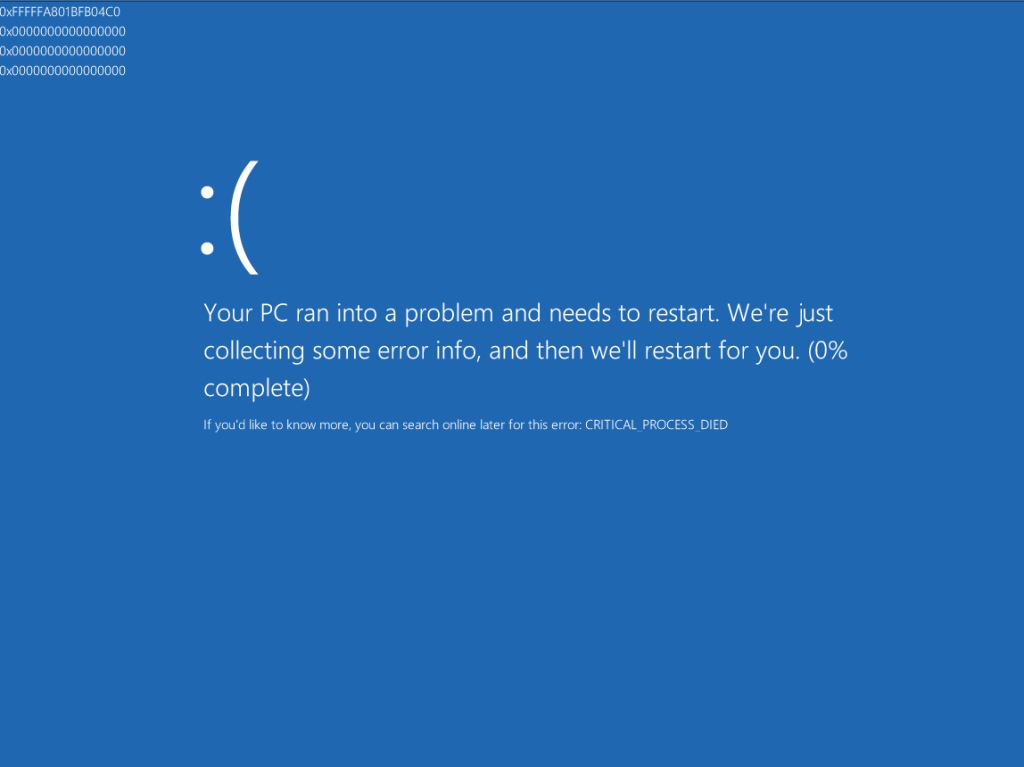-
-
products
-
resources
-
support
-
company
-
A Guide to the CRITICAL_PROCESS_DIED Blue Screen of Death Error
By Steve Horton April 30, 2013Blue Screen of Death, bsod, critical process died, critical_process_died46 Comments
Error Name: CRITICAL_PROCESS_DIED
You’ve encountered a rare thing — a Windows 8-exclusive Blue Screen of Death. BSoDs are historically very intimidating, but despite the name and appearance, most BSoDs are only temporary. This means that whatever error you’ve encountered can usually be fixed, though the process can be a bit of a pain. Previous versions of Windows flashed you with lines of code around the error message needed to diagnose what happened, but fortunately, Windows 8 put the message dead center and you were kind enough to document.

The Critical Process Died error in Windows 8.Now? Now you should just relax. You’ve done the hard part.
CRITICAL_PROCESS_DIED occurs when a process needed for the operating to run properly, well, dies. Processes are like programs, but multiple processes can be used by a single program- and processes directly interact with your processor, hence their name. The bad thing about this error is that it could be just about anything critical to the operation of your computer: namely, your hard drive, your memory, or, if you’re especially unfortunate, your processor.
When you turn your computer on, enter Safe Mode.
To enter Safe Mode in Windows 8:
- Restart your PC.
- Press Shift + F8 before the Windows logo appears.
- Click See Advanced Repair Options.
- Click Troubleshoot.
- Click Advanced Options.
- Click Windows Startup Settings.
- Click Restart.
- You then see a list where you can choose Safe Mode or Safe Mode with Networking (depending on whether you think you’ll need the Internet).
Once you do get into safe mode, be sure to check all of your drivers for issues. To do that, press Windows Key + X and click Device Manager, and from that menu, get Windows to check all of your devices for updates. If driver updates are available, install them. Be sure to remove any programs you installed when this started, and if, even after this, you encounter the CRITICAL_PROCESS_DIED error, then it’s time for you to do a full operating system re-install.
Well, not necessarily. You have two options to follow here.
The first option is a clean installation. You will lose all your data, but this is almost completely guaranteed to fix your problem. Press Windows Key + I, click Change PC Settings, click General, and click Remove Everything and Reinstall Windows.
The second option is a System Refresh. You will not lose your data, but your base operating system will still be re-installed. This is less likely to fix your problem, but may still work. To do this, follow the same instructions up until General — and select Refresh Your PC Without Affecting Your Files.
Once you’ve followed either one of those instructions, your problems should cease.
Note: If you use a Crucial M4 Series Solid State Drive, you may need to install new firmware for it. Visit the Crucial website for SSD updates.
If you’ve exhausted the options given in this article, call Microsoft or your manufacturer for further assistance.
Was this post helpful?YesNoFree Driver Updates
Update your drivers in less than 2 minutes to enjoy better PC performance - Free.
Free Driver Updates
Update your drivers in less than 2 minutes to enjoy better
PC performance - Free.
Didn't find your answer?Ask a question to our community of experts from around the world and receive an answer in no time at all.most relevant recent articles Pin It on Pinterest